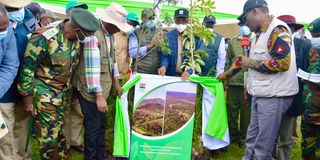Masterplan to restore degraded Cherangany-Elgeyo Hills launched

From left: Nema chairman John Konchellah (in blue) Jacket, Kenya Forest Service Senior Deputy Conservator of Forests Patrick Kariuki, Livestock PS Harry Kimtai, Nema Director-General Dr. Mamo B. Mamo, WWF-Kenya CEO Mohamed Awer, Environment CS Chris Kiptoo, North Rift Conservancy Ag. Head of Conservation Anthony Musyoka (right) during the launch of the Integrated Master Plan for the Rehabilitation and Restoration of Cherangany-Elgeyo Hills Ecosytem on July 23, 2021.
The Environment and Forestry ministry on Friday launched a masterplan for the restoration and rehabilitation of the Cherangany-Elgeyo Hills ecosystem to stem years of degradation and protect two key water towers.
The launch was held at Chepkorio show grounds in Elgeyo-Marakwet where locals, Community Forest Association members, conservationists and officials of various government entities had turned up to plant trees to mark the fifth Edition of the Annual Kaptagat Tree-Planting event.
Environment Principal Secretary (PS) Chris Kiptoo said the masterplan identifies a holistic approach to the restoration of the landscape covering four counties: Elgeyo-Marakwet, West Pokot, Trans Nzoia and Uasin Gishu counties.
“Today, we have launched the Cherangany-Elgeyo Hills Ecosystem restoration master plan for the rehabilitation of degraded areas in this important ecosystem that is home to two important water towers. I urge our local leaders and community to support & participate in restoration efforts,” said PS Kiptoo.
His call for support from the local community and leadership for the restoration agenda was also voiced by Tourism and Wildlife ministry’s Chief Administrative Secretary (CAS), Joseph Boinnet.
"The restoration of the Cherangany-Elgeyo Marakwet Hills ecosystem can only be done by us because it belongs to us,” said CAS Boinnet.
The ecosystem, which covers 414,928 hectares, lies within the Lake Victoria and Rift Valley drainage basins, draining its waters to Lake Victoria and Lake Turkana.
During this year’s annual tree-planting, stakeholders sourced 319,000 seedlings: 310,770 indigenous trees, 6,470 bamboo seedlings and 3,200 fruit trees.
The planting of the seedlings started on Monday, July 19, led by Kenya Forest Service foresters and members of Community Forest Associations.
"Kaptagat is known world over as one of the best high-altitude training grounds for our athletes and those from other countries. What better time to plant and restore the tree cover of this important ecosystem as our athletes train here for the Tokyo Olympics. What better platform to call upon our leaders to finance nature-based solutions and for climate action as a country, as we gear up for The Convention on Biological Diversity and the 26th United Nations Climate Change Conference (COP26), later this year,” said Mohamed Awer, Chief Executive Officer, World Wide Fund for Nature-Kenya (WWF-Kenya).
WWF-Kenya contributed 110,290 assorted indigenous tree seedlings and 3,090 bamboo seedlings for over Sh4 million to this year’s drive.
The seedlings sourced for this year’s event will help restore 225 hectares in the five blocks of Kaptagat Forest: Sabor, Kessup, Kipkabus, Penon and Kaptagat.
"Since the inception of the Annual Kaptagat Tree-planting initiative, we have restored over 425 hectares with about half a million trees planted. Through PELIS [Plantation Establishment and Livelihoods Improvement Scheme, the forest benefits at least 5,000 people in the area,” said Dr. Kiptoo, pointing to the success of the exercise in bringing together the community, stakeholders and policymakers for conservation.
The government set an ambitious agenda to plant 2 billion trees by 2022 and has embarked on mass production of seeds and seedlings through the Kenya Forest Research Institute (Kefri).
Recently, the Environment ministry directed Kefri to register and certify all tree nurseries in a bid to establish a framework to foster quality control and facilitation of enlisting potential partners in nature-based ventures, especially as an initiative to support growth of green jobs for youth in the country.
“If we have youth being encouraged to produce 1 million seedlings in each of the forest blocks which are here in Kaptagat, at the end of the year they will earn 30 million shillings. One indigenous tree seedling is being sold at 30 shillings. We require about 5 million shillings to do 1 million seedlings until they are ready to be grown. They will make 25 million shillings. Which is a huge amount. In fact, you don’t do any business that is as attractive as that,” added Dr. Kiptoo.




